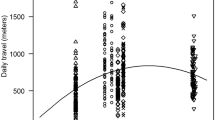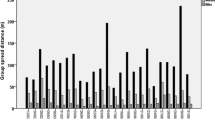Abstract
There has recently been increasing interest in group decision making, and in particular the mechanisms through which a group of individuals can arrive at a consensus decision. In this paper we investigate the effects of resource availability upon consensus decision making in a primate group. We extend an existing agent-based model of primate decision making to incorporate a model of diminishing foraging returns, and show that the difficulty of obtaining energy from the environment has an impact on successful strategies for consensus decision making in such groups. Moreover, the introduction of diminishing returns also results in better agreement between the predictions of the model and field studies of a naturally occurring primate group.
Similar content being viewed by others
References
Axelrod R (1997) Advancing the art of simulation in the social sciences. Complexity 3(2):16–22
Axtell R, Axelrod R, Epstein J, Cohen M (1996) Aligning simulation models: a case study and results. Comput Math Organ Theory 1(2):123–141
Conradt L, Roper T (2003) Group decision-making in animals. Nature 421(6919):155–158
Conradt L, Roper T (2007) Democracy in animals: the evolution of shared group decisions. Proc R Soc Lond B, Biol Sci 274(1623):2317–2326
Conradt L, Roper TJ (2005) Consensus decision making in animals. Trends Ecol Evol 20(8):449–456
Eberhardt L, Thomas J (1991) Designing environmental field studies. Ecol Monogr 61(1):53–73
Edmonds B, Hales D (2003) Replication and replication-some hard lessons from model alignment. J Artif Soc Soc Simul 6(4):11
Garnier S, Jost C, Jeanson R, Gautrais J, Asadpour M, Caprari G, Theraulaz G (2005) Aggregation behaviour as a source of collective decision in a group of cockroach-like-robots. In: Advances in artificial life, pp 169–178
Hill R, Lee P (1998) Predation risk as an influence on group size in cercopithecoid primates: implications for social structure. J Zool 245(04):447–456
King AJ, Douglas CM, Huchard E, Isaac NJ, Cowlishaw G (2008) Dominance and affiliation mediate despotism in a social primate. Curr Biol 18(23):1833–1838
Leca JB, Gunst N, Thierry B, Petit O (2003) Distributed leadership in semifree-ranging white-faced capuchin monkeys. Anim Behav 66(6):1045–1052
List C (2004) Democracy in animal groups: a political science perspective. Trends Ecol Evol 19(4):168–169
Luke S, Cioffi-Revilla C, Panait L, Sullivan K, Balan G (2005) Mason: a multiagent simulation environment. Simulation 81(7):517–527
Milinski M, Parker GA (1991) Competition for resources. In: Krebs JR, Davies NB (eds) Behavioural ecology. Blackwell, Oxford, pp 137–168
Pratt S, Sumpter D, Mallon E, Franks N (2005) An agent-based model of collective nest choice by the ant temnothorax albipennis. Anim Behav 70(5):1023–1036
Railsback S, Lytinen S, Jackson S (2006) Agent-based simulation platforms: review and development recommendations. Simulation 82(9):609–623
Sellers W, Hill R, Logan B (2007) An agent-based model of group decision making in baboons. Philos Trans R Soc Lond B, Biol Sci 362(1485):1699–1710
Stueckle S, Zinner D (2008) To follow or not to follow: decision making and leadership during the morning departure in chacma baboons. Anim Behav 75(6):1995–2004
Will O, Hegselmann R (2002) A replication that failed: on the computational model in Michael W Macy and Yoshimichi Sato: trust, cooperation and market formation in the US and Japan. J Artif Soc Soc Simul 11(3):3
Zappala J (2008) Multi-agent simulation of group decision making in animals. Master’s thesis. School of Computer Science, University of Nottingham
Author information
Authors and Affiliations
Corresponding author
Rights and permissions
About this article
Cite this article
Zappala, J., Logan, B. Effects of resource availability on consensus decision making in primates. Comput Math Organ Theory 16, 400–415 (2010). https://doi.org/10.1007/s10588-010-9080-4
Published:
Issue Date:
DOI: https://doi.org/10.1007/s10588-010-9080-4




